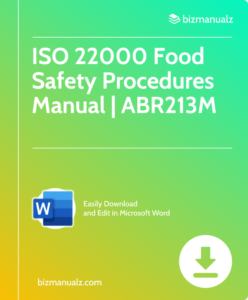What is the difference between HACCP and ISO 22000?

HACCP is a proactive approach to food safety, that looks for potential hazards and critical control points to keep those away from consumers. ISO 22000 is an international standard that looks at the overall risk management and continual improvement of the entire food production system. What is the difference between HACCP and ISO 22000?
Overview of HACCP
What is HACCP? It’s a systematic approach to ensure food safety, which involves identifying, evaluating, and controlling potential hazards in the entire food production process.
Why is it important? It helps protect against contamination and ensures that the final product is safe for consumers to consume.
How does it work? HACCP follows seven principles: hazard analysis, determining critical control points (CCPs), setting up critical limits for each CCP, monitoring procedures, corrective actions, verifying system effectiveness, and record-keeping.
Who should implement it? HACCP can be used by everyone involved in the food industry, such as producers, manufacturers, processors, and distributors.
Moreover, HACCP was originally developed in the 1960s by NASA and Pillsbury, to ensure the safety of foods for space missions. Since then, it has been widely adopted across many industries as a tool to prevent foodborne illnesses and guarantee consumer safety.
If you’re looking for even more assurance, ISO 22000 can provide the same level of security as a steel-reinforced concrete bunker.
Explanation of ISO 22000
ISO 22000 is a global standard for food safety management. It provides a structure to prevent food risks, manage threats, and guarantee the safety of food products in the whole supply chain. ISO 22000 covers all aspects of food safety, like interactive communication, system organization, prerequisite programs, and HACCP principles.
ISO 22000 is based on HACCP. This system is preventive for food safety. It involves assessing threats and carrying out measures to stop them from occurring.
ISO 22000 has a unique feature that focuses on communication and cooperation between all who make and sell food products. This ensures everyone is aware of their roles and responsibilities, and creates transparency and responsibility throughout the supply chain.
The importance of ISO 22000 is seen in a large food processing company. They had ISO 22000 standards, but faced a challenge when their supplier had contaminated ingredients. Thanks to their safe food management system, they identified the issue quickly and took corrective steps before any bad products went to customers. This showed the value of ISO 22000 in contamination prevention and maintaining consumer trust and protecting brand name.
Key Similarities between HACCP and ISO 22000
HACCP and ISO 22000 both focus on food safety management. Here are some similarities:
- Both are globally recognized.
- They assess and control food safety hazards.
- Procedures must be in place to manage food safety.
- Monitoring and verifying control measures is important.
- Regular audits and reviews are necessary for continuous improvement.
- A preventive approach is used to identify potential hazards.
An interesting find: According to the International Journal of Food Microbiology, combining HACCP principles with ISO 22000 can reduce the risk of foodborne illnesses.
Differences between HACCP and ISO 22000
Comparing HACCP and ISO 22000, we see they differ in several aspects. To explore, let’s use a table!
| Aspect | HACCP | ISO 22000 |
|---|---|---|
| Focus | Hazard identification & control | Total food safety |
| Structure | Flexible, custom-designed | Standardized framework |
| Scope | Individual products/processes | Entire food supply chain |
| Certification | Not mandatory, but widely recognized | Standardized certification process |
| Auditing | Internal audits by trained staff | External audits by certifying bodies |
HACCP’s focus lies in hazard identification & control. ISO 22000, on the other hand, has broader scope to ensure overall food safety. Structurally, HACCP is flexible whereas ISO 22000 follows a standardized framework.
Certification is not necessary for HACCP, but it is widely recognized. For ISO 22000, there is a standardized certification process. Lastly, auditing differs between the two systems. HACCP has internal audits carried out by trained staff while ISO 22000 requires external audits conducted by certifying bodies.
For maximizing effectiveness when implementing either system, tips include:
- Knowing specific requirements.
- Proactively identifying hazards & controlling risks.
- Updating & improving the system with regulations & industry best practices.
Following these tips will ensure greater food safety & regulatory compliance with HACCP or ISO 22000. Implementing HACCP guarantees food safety. Who wants salmonella with their lunch, after all?
Benefits of Implementing HACCP
HACCP offers a few advantages that increase the efficiency and safety of food production. Firstly, it helps spot and control potential risks in food production. Secondly, it raises product quality with strict monitoring procedures. Thirdly, it complies with international food safety standards. Finally, it bolsters consumer trust in a brand’s commitment to safe and high-quality products.
HACCP was first developed by NASA and Pillsbury in the 1960s. They made this system to guarantee food safety for astronauts. This work led to the widespread use of HACCP across many industries, making it an important part of food manufacturing.
Implementing ISO 22000 grants not only food safety, but also an excuse to dress up in a lab coat and act like a culinary scientist.
Benefits of Implementing ISO 22000
ISO 22000 has many advantages to help organisations guarantee food safety. These include:
- Improved Food Safety: ISO 22000 offers an organised way to spot and control food safety dangers, decreasing the probability of contamination.
- Better Consumer Trust: Adopting ISO 22000 shows a dedication to food safety, escalating consumer confidence and trust in the organisation’s products.
- Better Compliance: ISO 22000 assists organisations in adhering to regulatory needs connected to food safety, guaranteeing legal conformance and avoiding fines.
- Efficient Risk Management: With ISO 22000, organisations can efficiently assess and handle risks related to their food procedures, reducing potential issues.
- Continuous Improvement: ISO 22000 endorses a culture of continuous enhancement by creating corrective actions, preventive steps, and performance tracking systems.
Apart from these benefits, ISO 22000 also permits organisations to create a reliable food safety management system that is consistent with internationally accepted standards. This recognition increases their reputation in the worldwide market.
A research conducted by “The Journal of Food Engineering” confirms the advantages of ISO 22000. They discovered that organizations certified with ISO 22000 displayed improved production procedures and heightened customer approval.
By implementing ISO 22000, organizations can benefit from these rewards and guarantee the delivery of safe and high-quality food products to customers. But, don’t forget, whether it’s HACCP or ISO 22000, food safety is no joke… unless it’s a dark, twisted one-liner!
HACCP and ISO 22000
ISO 22000 is one-of-a-kind. It requires companies to review and upgrade their food safety management system regularly. This helps to stop foodborne illnesses and satisfy customers.
ISO 22000 also combines components of other management system standards. For instance, ISO 9001 for quality management and ISO 14001 for environmental management. This makes processes more efficient and earns multiple certifications at once.
The International Organization for Standardization (ISO) published ISO 22000 for the first time in 2005. ISO is a non-governmental organization that produces international standards.
Frequently Asked Questions
 Q: What is HACCP?
Q: What is HACCP?
A: HACCP stands for Hazard Analysis and Critical Control Points. It is a systematic approach to identifying, evaluating, and controlling food safety hazards.
Q: What is ISO 22000?
A: ISO 22000 is an internationally recognized standard for food safety management systems. It provides a framework to effectively manage food safety hazards and ensure the delivery of safe food products.
Q: What is the main difference between HACCP and ISO 22000?
A: While both HACCP and ISO 22000 are food safety management systems, the main difference lies in their scope. HACCP focuses primarily on hazard analysis and control points, while ISO 22000 covers a broader range of food safety management aspects.
Q: Can a company be HACCP certified without having ISO 22000 certification?
A: Yes, it is possible for a company to be HACCP certified without having ISO 22000 certification. HACCP certification specifically verifies that a company’s food safety management system meets the HACCP requirements, whereas ISO 22000 certification covers a wider range of food safety management aspects beyond HACCP.
Q: Which one should I choose, HACCP or ISO 22000?
A: The choice between HACCP and ISO 22000 depends on several factors such as the scope of your operations, regulatory requirements, and customer expectations. HACCP is often mandatory in certain industries, while ISO 22000 provides a more comprehensive approach to food safety management.
Q: Is ISO 22000 certification more globally recognized?
A: Yes, ISO 22000 certification is more globally recognized as it is an internationally accepted standard for food safety management systems. It is recognized by regulatory bodies, customers, and stakeholders worldwide, which can enhance market credibility and facilitate international trade.
















Leave a Reply